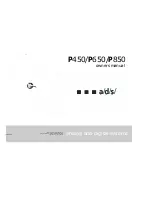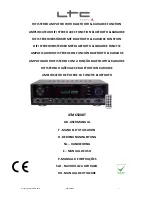
the control of the system.
5, 6, 7. Solar Tank Bypass Valve Assembly:
For
two tank systems only. Assembly of three ball valves
allows the solar tank to be completely isolated and by-
passed in the case of tank failure. When the solar tank
is bypassed, water will be heated by the auxiliary heat-
er only. Solar bypass valve assembly may also be a
combination of two 3-way valves or a single 4-port sin-
gle action bypass valve.
8. Mains Supply Line Isolation Valve:
When open
allows potable water to fill the solar storage tank or
back-up water heater. When closed isolates the solar
storage tank and back-up water heater from the pres-
surized city cold water supply line.
9. Pressure Relief Valve (PRV):
Will discharge heat
transfer fluid (water) from the collector closed loop at
the PR valve pressure setting, (typically 75 – 150 PSI).
Under normal operating conditions, the pressure relief
valve will not discharge fluid. If this valve opens and
water is expelled contact your contractor immediately.
This valve also can be manually opened to assist filling
or draining the collector loop.
The PRV protects the collector and all components in
the collector loop from pressures in excess of the PRV
pressure setting.
WARNING: THE PRESSURE RELIEF VALVE SET-
TING MUST NOT BE HIGHER THAN THE MAXIMUM
WORKING PRESSURE OF THE COMPONENTS IN
THE COLLECTOR LOOP.
10. Drainback Reservoir:
An insulated storage res-
ervoir that holds the collector and solar loop piping
heat exchange fluid (water) when the circulating pump
is off.
11. Solar Flush Combination Valve:
Used to charge
and drain the solar loop piping.
12. Circulating Pump:
Circulates water through the
collector and solar loop piping to the hot side of the
external heat exchanger.
13. Potable Circulating Pump:
Circulates water
from the storage tank through the cold side of the ex-
ternal heat exchanger.
14. External Heat Exchanger:
Transfers heat from
the hot water circulating through the solar collector to
the potable water circulated through the solar storage
tank.
17. Differential Temperature Controller:
Automati-
cally turns the circulating pump on and off when there
is sufficient heat to be gained in the solar collector.
18. Heating Element & Tank Thermostat:
The aux-
iliary water heater thermostat controls the temperature
setting of the auxiliary heating element.
19, 20. Temperature and Pressure Relief Valve:
Universally required by the plumbing code on water
heaters. Will automatically release and dump water at
either 150 PSI of pressure or 210° F in temperature.
21. Mixing Valve:
Automatically blends hot water
from the solar storage tank with incoming city cold wa-
ter to an acceptable set point. A mixing valve must be
installed on every Torrent Drainback solar water heat-
ing system. The mixing valve may include and integral
check valve to prevent backflow of mixed or hot water
into the cold water feed line. When the mixing valve
does not include an integral check valve, an external
check valve should be placed on the cold feed to the
mixing valve. In two tank systems the mixing valve
may be located; either at the outlet to the solar stor-
age tank; or at the outlet to the auxiliary heater.
22. Pump Throttling Valve:
May be partially closed
to reduce the flow rate and prevent pump cavitation.
24. Potable Flush Combination Valve:
Used to flush
the potable loop and isolate the heat exchanger.
35. Solar Flush Combination Valve:
Used to flush
the solar loop.
36. Potable Flush Combination Valve:
Used to flush
the potable loop and isolate the heat exchanger.
11) ESTIMATED COMPONENT LIFE
You can expect a long and useful like from the primary
components in your Cascade 2 solar water heating sys-
tem by adhering to the routine service and mainte-
nance tips provided above.
The SunEarth solar collectors have a design life of 25
to 30. The solar storage tank should last 12 to 20 years
in most areas provided the anode rod is periodically
replaced. The circulating pump and differential control
should last 10 to 15 years before needing replacement.
Like EPA mileage estimates for automobiles, these
component design lives represent average figures for
system components installed in the United States. Life
of your components may vary.
To obtain warranty service, please see the completed
Appendix F in the back of this manual with your instal-
lation contractor contact information or contact
SunEarth Inc. for the name of an authorized service
agent near you.
12) SYSTEM OPERATING PARAMETERS
12.1 Collector Loop Pressure
The pressure in the solar collector loop should be within
0 – 20 PSIG.
12.2 Circulation Flow Rate
The flow rate in the collector loop should be 0.5 – 4
GPM when the pump first comes on (filling the collector
loop). Once the collector loop is full and water starts to
siphon down the return piping the flow rate will nor-
mally increase and should be 0.8 – 5 GPM with the sys-
tem circulating.
12.3 Temperature Differential
The temperature difference between the collector outlet
Summary of Contents for CASCADE 2
Page 29: ...APPENDIX F ...
Page 30: ...APPENDIX F ...













































